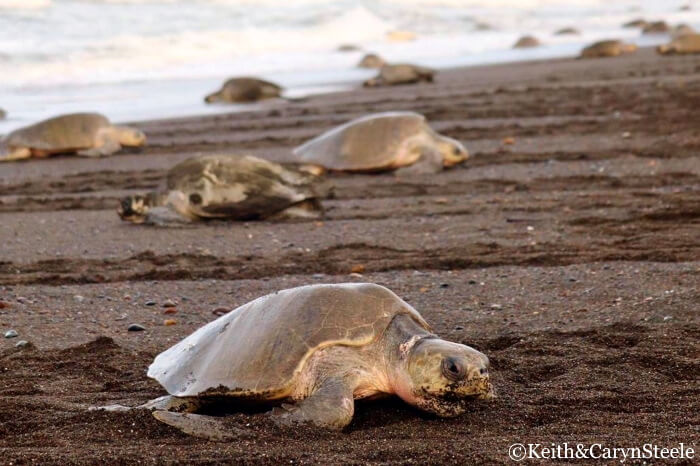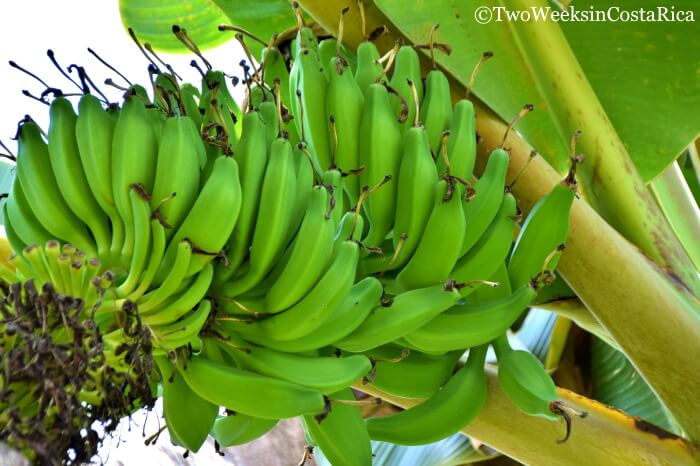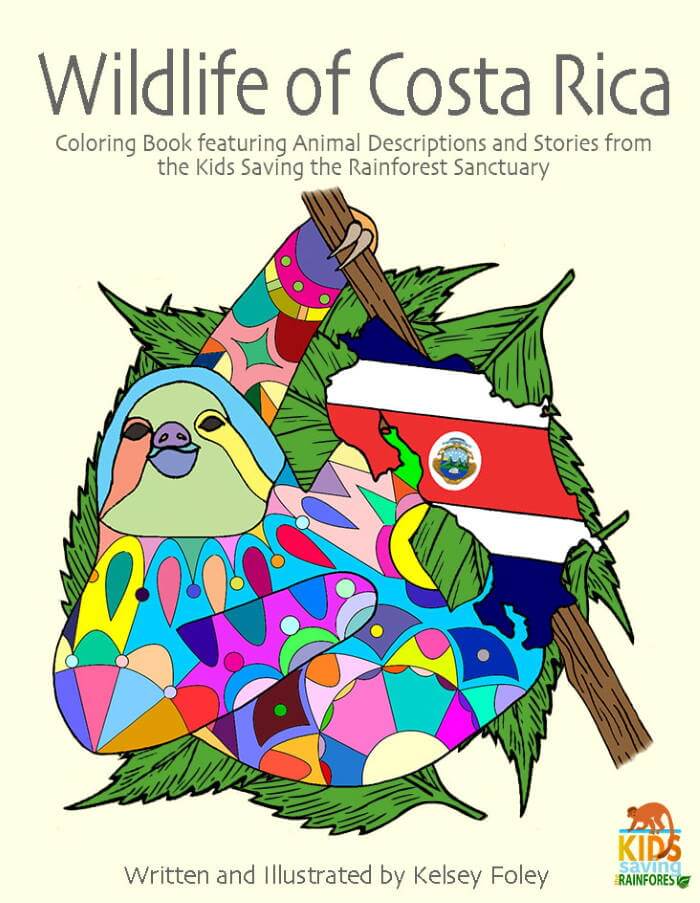In Part 1 of our virtual field trip to Costa Rica, we had you discover wildlife through guidebooks and trail cameras, taught you how to make homemade beans (yum!), planted a pineapple, and gave a list of fun books related to Costa Rica. In this second part of our virtual field trip, we give even more exciting ways to connect with and experience the country from afar. Below we will bring you through some museums, talk about active volcanoes, learn about sea turtles, and cover other cool stuff that makes Costa Rica unique.

Discover Costa Rica’s Sea Turtles and Learn About Their Conservation
Costa Rica’s oceans have five species of sea turtles. Most are endangered and others are on the brink. There is a lot of hope, though, especially with dozens of conservation groups around the country lending a hand along with the hundreds of volunteers they organize.
Probably the best way to learn about sea turtles is to hear from the people who are helping them.
Tortuguero
First, let’s go to what might be considered Costa Rica’s sea-turtle capital: Tortuguero. Tortuguero is a small village on the Caribbean side of the country with miles of beach. Every year, thousands of sea turtles make their way to these beaches to lay their eggs on the sand. Amazingly, sea turtles return to the very same beach that they were born to lay their eggs! In Tortuguero, the two main types of sea turtles are green sea turtles and the rarer, leatherback turtle.
Turtle groups in Tortuguero host many volunteers to help with conservation efforts. These are often students or young people who want to be biologists or have an interest in environmental issues.
To catch a glimpse of what it’s like to be a sea-turtle volunteer in Tortuguero, check out these two videos about the Sea Turtle Conservancy.
Video 1: Volunteering with the Sea Turtle Conservancy in Tortuguero
Video 2: Meet the Team Protecting Costa Rica’s Sea Turtle Mecca – Follow along with the research assistants to see baby turtles hatching!
Playa Ostional
For more turtle action, we can go to the opposite side of the country and the shores of the Pacific Ocean (yes! Costa Rica has two coastlines). On the Pacific, sea turtles also come to beaches to nest. In fact, at one beach called Playa Ostional, something completely unexpected happens. Almost once per month, thousands of olive ridley sea turtles gather in the waters offshore and come to land to nest at the exact same time. This amazing phenomenon is called an arribada.
You can view one of the biggest ever recorded with this National Geographic article and video. Playa Ostional is the only beach in Costa Rica, and one of the only places in the entire world, where arribadas occur.

Osa Peninsula
Finally, we can go to the very southern part of Costa Rica’s Pacific coast to learn an important piece of sea-turtle conservation: how a turtle hatchery works. Here’s a link to a video from Encyclopedia Britannica that shows you a hatchery on the Osa Peninsula.
Basically, the way it works is volunteers at turtle hatcheries gather eggs once they are laid and protect them in an enclosure on the beach. They keep track of how long they have had the eggs to predict when they will hatch, and once hatched, they help the hatchlings return to the sea.
An important point that the video above does not address is the role these hatcheries play in protecting nests from poachers. Poachers are people who dig up turtle eggs from the beach to sell them. They do this because of a local belief that the eggs are a natural aphrodisiac, so one turtle egg can sell for a high price tag, relatively speaking. In Costa Rica, poaching is a major threat, and conservation groups are continuously working with local schools to teach future generations about the importance of sea turtles.
The conservation group featured in the video above is part of Osa Conservation (formerly Friends of the Osa), but there are many other turtle programs around Costa Rica that are doing similar work to help protect sea turtles.
Maybe someday you could be a turtle volunteer too?
Virtual Museum Tours – Discover Ancient Sculptures, Tools, and Artifacts
Costa Rica’s culture goes way back to pre-Columbian times. Yes, thousands of years ago, mysterious civilizations thrived in the jungle. Today, banana farmers have found giant rock spheres, construction sites have dug up gold jewelry and pottery, and landowners have even stumbled upon an ancient city with complex stone roads. Archeologists have pieced all these treasures together to study Costa Rica’s beginnings.
A cool way to learn about this history is through museums. There are two good ones located in Costa Rica’s capital city of San Jose that you can also visit online.

National Museum
The National Museum is a fun place to start. The purpose of this museum is to bring visitors on the journey from Costa Rica’s ancient civilizations to modern day. The museum shares the history of pre-Columbian cultures, all the way through the arrival of the Spanish, political changes within the country, and even modern-day influences.
The National Museum’s website has online exhibit pages that explain more about each room. We would suggest the Pre-Columbian History Exhibit and Costa Rica History Exhibit (from 16th century to today). On those pages, you’ll read a lot of detailed information and see plenty of pictures (select English at the top right). Then you can click to enter a virtual room. The rooms aren’t very interactive (more information on the pages), but you can get a 360 degree view of the museum and see some of the artifacts and displays.
Jade Museum
Costa Rica’s Jade Museum has an even better online tour if you want the feeling of walking through an actual museum. Just click on this link to get to the homepage, and under the Exhibitions tab, click Virtual Tour.
Jade is a type of precious stone that ancient Costa Rican civilizations often used. You’ll be able to see some pretty awesome jade carvings on this virtual tour as well as other artifacts made from different materials like stone or gold. Just click on the circles to move around and for information about each artifact (in Spanish and English).
Guayabo National Monument
History buffs may also like the post we wrote about one of Costa Rica’s most fascinating archeological sites, Guayabo National Monument. This site was thought to be a small city in its heyday. It has roads, drainage, and building foundations that still can be seen today.
Volcanoes – Costa Rica’s Fiery Mountains
Costa Rica is home to more than 20 volcanoes. Some are extinct or dormant, but others are still active and impressive. A few are even erupting off and on to this day. Costa Rica has so many volcanoes because of its position along the so-called Ring of Fire. This is the area around the edge of the Pacific Ocean where most of the world’s volcanic activity takes place.
Let’s take a look at four of Costa Rica’s most famous volcanoes.

Arenal Volcano (Stratovolcano)
Though this cone-shaped volcano is only puffing steam these days, it is probably the country’s most famous. That’s because in 1968, it had a massive surprise eruption that caused a lot of destruction. In the years following (up until early 2000s), this volcano could be seen spewing lava and rocks from its pointy top. It was especially spectacular at night. Here’s a picture to give you an idea.
If you are planning to visit Costa Rica, this is one destination that should be on your list. Even if there is no lava flowing these days, the huge cone-shaped volcano in front of you, with its ashen gray lava stains, is a sight to see. Plus you can still walk the old lava fields at the area’s national park and reserves.
Poas Volcano (Stratovolcano)
Located very close to Costa Rica’s capital city of San Jose, this volcano features the world’s largest crater and crater lake that you can gaze down at from a viewing platform (clouds and volcanic activity permitting). Poas has been active for the last few years, and in one 2017 explosion, the monitoring camera got destroyed and visitor center building was struck with flying volcanic rocks. Check out this video to see how it happened (skip to around 5:30 to see the explosion and related damage). Don’t worry, no one was hurt, and the park has since installed shelters in case it happens again when visitors are present.
Turrialba Volcano (Stratovolcano)
This is another volcano that has been putting on a show for the last few years. Quiet since 1866, Turrialba came back to life in three phases starting as early as 2006. It wasn’t until 2015, though (phase 3), when things really started heating up. At one point, airplanes were unable to land or take off in San Jose because there was too much volcanic ash in the air. This video shows the progression and stages of Turrialba’s reactivation over the years. One other cool fact about Turrialba Volcano is that it has three craters at the top and two on the side!
Rincon de la Vieja Volcano (Complex Volcano)
Speaking of multiple craters, a volcano named Rincon de la Vieja in Costa Rica’s northern region has at least nine eruptive centers. This is what scientists call a complex volcano because the volcanic activity takes place along a ridge and moves through channels. At Rincon de la Vieja, for example, volcanic activity has shifted to the southeast, where the youngest craters are located.
A fascinating fact is that the tallest part of the Rincon de la Vieja complex has a 500 meter (1,640 foot) wide crater and acid lake at the top! Rincon has been giving us a show lately with several minor eruptions. Here is a video of one of them that also gives a glimpse at the crater lake.
For more cool videos of Costa Rica’s volcanoes exploding, check out the OVSICORI-UNA YouTube channel. You can find a map of all volcanoes in Costa Rica here.
Fun Volcano Activity with Kids
An interactive way to teach kids about volcanoes is to make your own at home. Here’s a link to an affordable DIY kit that looks a lot like Arenal Volcano. You’ll be able to mold it, paint it, and of course, make it erupt!
Bananas – One of Costa Rica’s Most Important Crops
Bananas are one of Costa Rica’s main crops. In fact, a 2015 study found that one of every 10 bananas eaten in the world came from Costa Rica. Go check the label of yours to see where they came from.
But How Do These Delicious Fruits Grow?
We have all seen a “bunch” of bananas in pictures, right? One commercially grown bunch can have around 200 single bananas on it (473 is the record). These giant bunches are produced on a single banana plant. It’s not a tree or a bush, but a leafy plant that is actually considered a perennial herb. Perennial herbs don’t have any woody parts and come back again and again without replanting. Some common ones you may know are chives, rosemary, oregano, and mint. Strange that bananas fit into this category, but true.

It can take up to nine months or even a year for the banana plant to form the flower, which turns into a bunch of bananas. Surprisingly, after the bananas mature and are harvested, the plant is cut down. Yup, chopped right down to the ground. That’s because each plant only produces one bunch of bananas in its life. Luckily, little baby plants (called suckers) pop up around the old roots and create new banana plants.
The Growers
To see how bananas grow from a sucker all the way to maturity and eventually find their way to your local grocery store, you can visit (virtually) Earth University. They have a large banana-growing operation in Costa Rica and go through it step by step. Just click on the small pictures in the article to enlarge them and read about the process as you go.
Now, just like the pineapples from our previous post, some banana farms are more sustainable than others. Earth University is a good one, but for a better behind-the-scenes look, check out this article and video of a Rainforest Alliance farm in Costa Rica. You’ll learn how some simple agricultural practices are making a big difference for the environment and why you should consider buying these types of bananas yourself.
Wildlife Coloring Book – To Benefit a Local Non-Profit
Finally, to finish off Part 2 of our virtual field trip, we will leave you with a beautifully designed coloring book available for purchase online. This will be sure to keep both kids and artsy adults busy while waiting to visit Costa Rica in person. Proceeds from this book go to a wildlife rehabilitation facility near Manuel Antonio called Kids Saving the Rainforest (KSTR).
Kids Saving the Rainforest is an organization that does important work to protect and rehabilitate wild animals like sloths, monkeys, parrots, and all kinds of other jungle creatures. In the 52 page-book, you will learn about many of the animals they help with some interesting facts about them. The sloth page, for example, explains why a sloth’s fur is sometimes green. On the adjacent pages, there are beautiful illustrations in a mandala style (geometric) to color or paint. Since the illustrations are made up of many smaller shapes, you can get as detailed as you’d like. This book makes a great gift for family members in need of activities or as a learning supplement for kids schooling from home.
We hope our virtual field-trip posts have brought you closer to Costa Rica if you are unable to visit right away. We’d love to hear what types of activities you’ve done at home and how they’ve made you excited about an upcoming trip.
Did you try some of these field-trip ideas at home? Leave us a comment below.
Some of the links in this post are connected to affiliate programs we have joined. As an Amazon Associate we earn from qualifying purchases.
Looking for more information about Costa Rica? Check out these posts:
Best National Parks in Costa Rica – Costa Rica is home to more than 27 national parks. Check out this list of the ones you can’t miss.
Costa Rica Destinations Summary Guide – This post gives a quick paragraph about each of Costa Rica’s destinations. It’s a great way to sift through your options.
Best Time to Visit Costa Rica – Planning or re-planning a trip to Costa Rica? Check out this post for good (and bad) times to visit.

